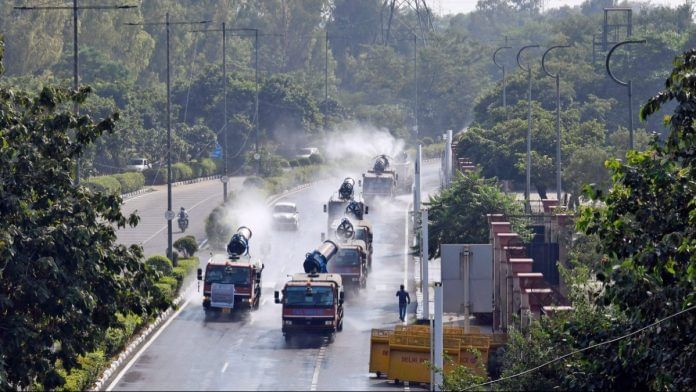New Delhi: Not a single Indian district meets the global air quality benchmark, a new study has found. And about 60 per cent exceed the national standard for annual PM2.5 levels.
The report by the Centre for Research on Energy and Clean Air (CREA), drawn from high-resolution satellite data, offers a panoramic view of India’s air. Out of the 749 districts it analysed, not a single one met the World Health Organisation (WHO) guideline of 5 μg/m³ for annual PM2.5. And a total of 447 out of 749 districts crossed the National Ambient Air Quality Standards (NAAQS) of 40 μg/m³.
The study analysed 33 states and union territories. Ladakh, Andaman & Nicobar Islands, and Lakshadweep were excluded due to insufficient ground monitoring data.
Southern states cleanest
With 11 districts each, Assam and Delhi together accounted for nearly half of the 50 most polluted districts. Haryana and Bihar, with seven each, were right behind.
In Delhi, Tripura, Punjab, Haryana, Himachal Pradesh, Meghalaya, and Chandigarh, every district breached the standard except during the monsoon.
Winter, unsurprisingly, was the worst offender. Around 82 per cent of districts exceeded the NAAQS during this period. While summer brought some respite, it still left more than half the country breathing unhealthy air. During the monsoon, only 10 per cent of districts exceeded the NAAQS, but the number shot back up to 75 per cent immediately after.
The report shows that India’s battle for clean air is no longer about metro cities and smog-filled winters. It’s a year-round, country-wide struggle.
“India’s clean air challenge can no longer be viewed through the narrow lens of city pollution or winter smog. The latest data clearly show that poor air quality persists through most of the year, affecting nearly every region of the country,” said Manoj Kumar, analyst at CREA.
Of the 33 states and union territories studied, 28 had at least one district crossing the annual NAAQS. Not a single state met the WHO guideline.
Delhi bore the heaviest burden, with a population-weighted annual mean of 101 μg/m³, two and a half times the NAAQS and 20 times the global benchmark. A ‘population weighted annual mean’ shows the average pollution level, except that it focuses more on places where more people live.
Southern states offer a ray of hope, presenting the lowest PM2.5 values. Puducherry recorded the lowest concentration at 25 µg/m³, followed by Tamil Nadu, Karnataka, Telangana, Kerala, and Andhra Pradesh.
Also read: How an ash cloud produced by a volcanic eruption in Ethiopia reached India
Airshed analysis
At the centre of the report is airshed analysis. An airshed is an area of the atmosphere where local geographical features, such as mountains or weather conditions, limit the movement and spread of air and pollutants. Within an airshed, pollutants circulate with the air coherently, creating similar air quality within its boundaries.
The report found that the Indo-Gangetic airshed remains the most polluted in the country. But the Northeast airshed is a new concern, where states such as Assam and Tripura show increasing pollution not just seasonally, but throughout the year. Even the monsoon showers offer little relief.
All airsheds in the country—except the Northeast airshed—briefly dipped below the national PM2.5 standard of 40 μg/m³. But, as soon as the rains withdrew, the smog came back, indicating that baseline emissions are the core problem.
“Without airshed-based governance frameworks, satellite monitoring integration into NCAP, sectoral emission targets, and accountability mechanisms, millions in non-metropolitan India will remain locked out of clean air policy and locked into chronic pollution exposure,” Kumar said.
(Edited by Prasanna Bachchhav)






